Day 1 of 5 from CAST 2025
VIDEO LINKS:
Chris: Greetings, readers of Acres Online and buZZ!, and welcome to the 2025 edition of Acres of buZZ!, where we take you on a daily recap tour of the California Spring Trials—better known as CAST. I don’t think I have to explain beyond this ... Bill and I started this thing in 2005—20 years ago. Remember, Bill? You were just a wee lad and I think it was your second day on the job at Ball Publishing.
Bill: It was ... and I was equally excited and scared to death to cover trials with a pro like you. But it ended up being a fantastic trip—and still is. Hard work, but worth it because we get to share all the cool new stuff with tens of thousands of greenhouse and garden center professionals who can’t make the trip west.
Chris: I trained you well! And that was the year we were dubbed “The Bobbleheads." Of course, for a good number of years when you weren’t an editor, you actually worked behind the scenes at Ball, designing, setting up and running the trial. I can’t claim that. What did you learn from that experience that helps you cover the trials?
Bill: I learned a lot, but first and foremost was the amount of labor and teamwork that’s required to pull off an event like this. Hundreds of people work tirelessly to make sure every plant, display and message is on point. Shout out to all of our readers at the exhibiting breeding companies!
Chris: Much like producing this live coverage from the road—we’ve got videographer Osvaldo Cuevas hard at work on his Mac editing video, and editor Jen Zurko copyediting and proofreading and double-checking species names. The four of us pretty much live together for five days to bring you all the important highlights from those breeders—in words, pictures and videos. Be sure to click the links at the top or in each section to check out those videos! And watch our social media feeds on Facebook and Instagram.
Bill: Like you always say, Boss, life’s too short to read boring trade media so our goal is to share a ton of new variety info and have fun doing it. We’re pretty serious in the newsletter, but the videos include plenty of shenanigans! Social media, on the other hand, is all about plant pics.
Chris: Well said, young William! But enough of the chit-chat. Let’s dive into the biggest single stop of the five days: the Ball Companies, hosted at the Santa Paula location of PanAmerican Seed. How should we tackle Ball’s five breeding companies?
Bill: Hmmmm ... let’s kick it off with PanAm, who always brings the heat with like 493 new varieties. I exaggerate only slightly, but they had a lot. How about we each tackle three heavy hitters?

PanAmerican Seed
Chris: Easy! And easy for me to pick Wave petunias, which dominated the space. First, it’s Wave’s 30th anniversary—it was way back in 1995 when they launched the now-famous Purple Wave, bred by Japanese brewery Kirin but introduced (and now owned) by PanAmerican. The line has grown exponentially since then, to include Easy Wave, Tidal Wave, Shock Wave, E3 ...

New to the collection this year is Easy Wave Pink Pearl, which has pretty, pale pink flowers with a hint of rose in the throat and rose veins. (Pearl happens to be the 30th wedding anniversary gemstone).
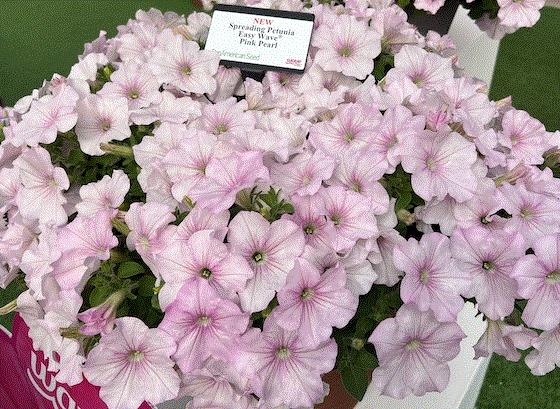
Shock Wave, the small-flowered member of the Wave family, gets two additions—Rose Vein and Violet—and two improvements—Red Improved and Deep Purple Improved, both now having better tolerances for cold-growing.
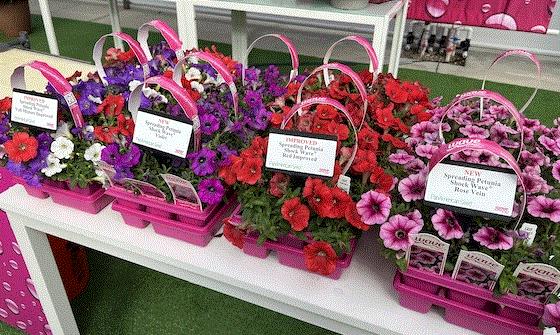
I’ll add in a non-petunia: new Top Wave pansy, which joins Cool Wave in the Wave Pansy brand. Top Wave was bred to have flowers all over the top of the plant (Cool Wave is known to get a bit of a bald spot on top). Top Wave is also more of a grandiflora type, with 25% larger flowers than Cool Wave. But it’s still spreading, and great for spring for fall, like Cool Wave. The series starts with eight colors.
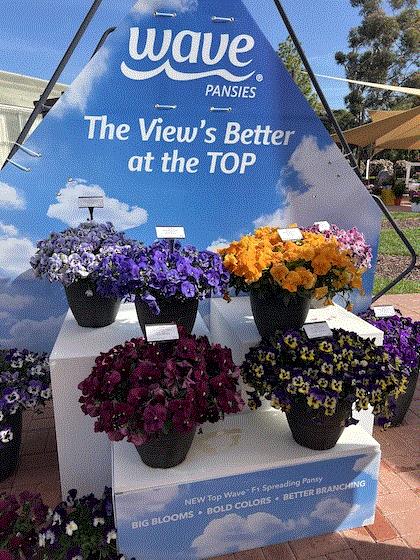
The last bit of Wave celebration news is big, really big: PanAm has partnered with legendary photographer Anne Geddes to create Wave Petunia baby portraits. And they’ll be announcing a contest this spring where a lucky Wave consumer will win a baby portrait by Ms. Geddes. Big-time stuff!
Bill: Yeah, she’s legendary, and so is Wave. Newer, but certainly critical to the industry as a whole is Beacon—the impatiens with high resistance to impatiens downy mildew. When PanAm launched Beacon with a limited color range, we all knew they’d keep adding colors and now, they’re up to 10 covering the range consumers and landscapers need. New for 2026 are Light Pink and Blue Pearl, key impatiens colors for sure. And the charities supported through sales of Beacon were announced, as well: Extra Special People (providing opportunities for people with disabilities in the U.S.) and Green Fingers, in the UK, which provides therapeutic gardens and experiences for children in hospice.
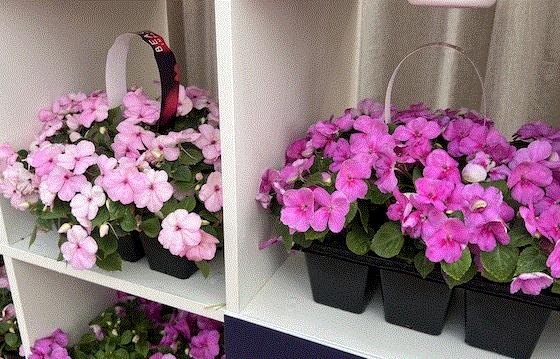
While I’m in the shade with Beacon, might as well talk Solarscape—the first and only interspecific impatiens from seed. New in the standard-sized lineup is Salmon Punch and for the taller XL range is a mix called Brilliant Gems, which includes lilac, hot pink and blush shades for a pop of color in shady spaces. We did get a tip from the experts at PanAm that you really should grow these on the dry side for best results.
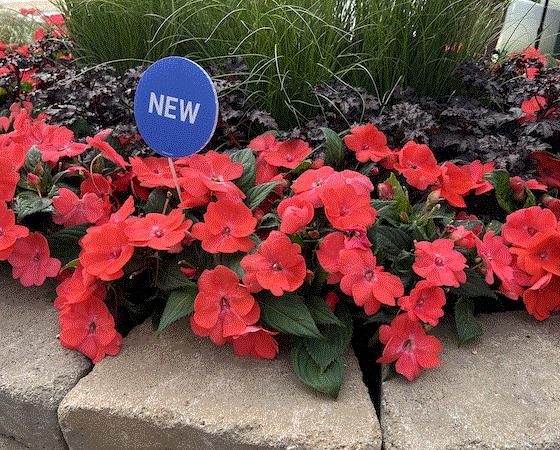
Chris: Let me mention one more notable: coleus Sweet Paprika, part of the Premium Sun line. These seed coleus look just like their big, bold vegetative counterparts to me, but they’re from seed, meaning a lower-cost input. I don’t think you give up a thing, including performance in sun or shade. The line now has 11 colors.
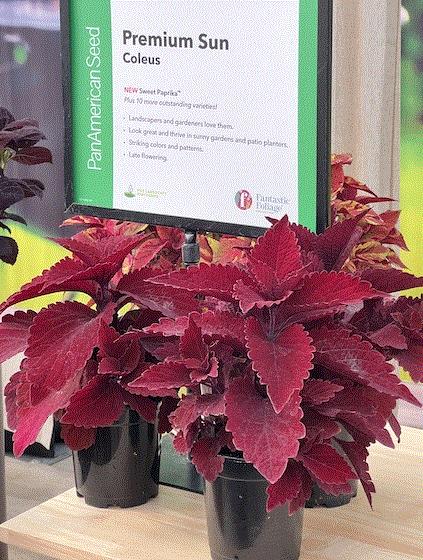
CLICK HERE to watch our PanAmerican Seed video. Now Bill, how about a few favs from BFP?

Ball FloraPlant: Positioning for customer success
Bill: BFP—better known as Ball FloraPlant—has done something cool for the past couple years that I’ve talked and written about quite a bit. They’ve very clearly positioned each major category in their assortment to make it simple for growers and retailers to select series to fit different needs. For example, angelonia. BFP has five series: Guardian Angel (extra-large), AngelDance (large), Archangel (medium), AngelFlare (medium v-shaped) and AngelMist (spreading). Knowing the habit helps with container selection, landscape or combo use and even performance by region. New for 2026 in Guardian Angel is Pink, bringing the second-year series to three. Archangel adds Fuschia and Light Pink.
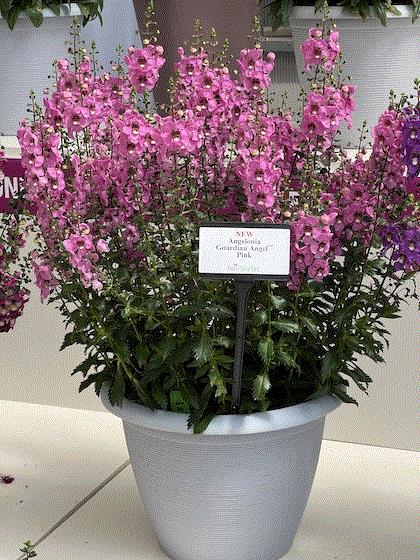
Similarly, BFP lantana is also well-positioned with five series from the large, spreading Landmarks to compact and mounded Little Luckys. We saw three new ones for the medium-mounded Shamrock series—Lavender, Yellow and Lemon Glow. They're all nice, key colors. but my eyes kept going to the Passion Fruit pot on the same table. Seriously, that’s one of the coolest introductions in the past five years. But I digress ... gotta stick to the NEW or we’ll be here all day.

Chris: So many choices! But most significant—if the market likes it—might be Geranium Solera Dark Red, an interspecific meant to compete directly against Calliope from Syngenta. On the surface it looks good, with a deep red color, although to my eye the foliage leans a bit more toward the ivy than the zonal geranium. Customers will be the final judge! Solera also gets Purple—a great color, but perhaps not as significant as Dark Red.
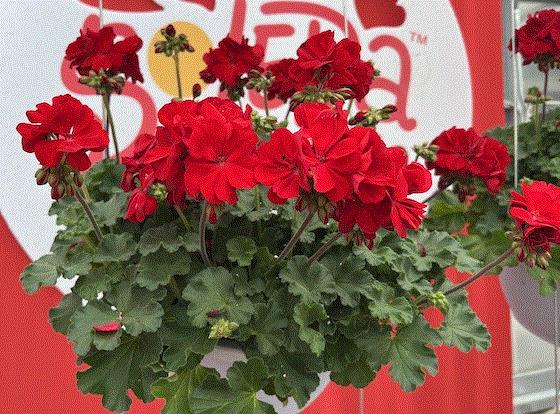
Bill: When a “mainstay” series is dropped, it’s news to report on. Fiesta Double Impatiens were a biggie in the BFP assortment for years, but when Impatiens Downy Mildew (IDM) ravaged the I. walleriana market, they took a big hit. But with so many breeders in the Ball company, Beacon helped save the market for seed impatiens and now Ball FloraPlant has a vegetative double series with the same high resistance to IDM (released two years ago)—Glimmer. Fiesta is officially gone; Glimmer is here in its place. Two colors were added for 2026: Purple Stardust and Strawberry Sparkler, bringing the series color count to 10.
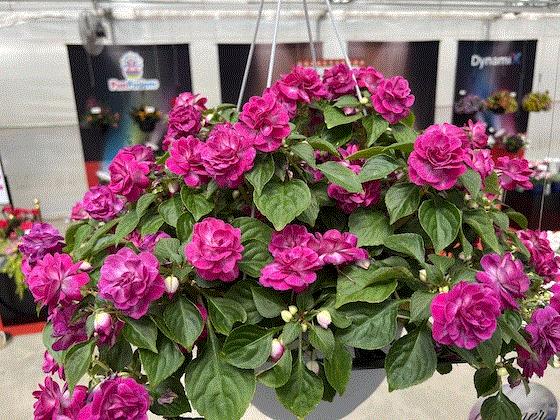
Chris: I mention in our video that Salvia farinacea is my favorite annual because of how bulletproof it is under any conditions—it always seems to look fresh and happy. BFP has three lines of S. farinacea or S. farinacea crosses: the giant Mystic Spires, the mid-sized Mysty and now the compact Salvia Mystical—crisp and clean, with nice flowers held up on calyx that pick up the flower color. There are two colors: Blue and White.
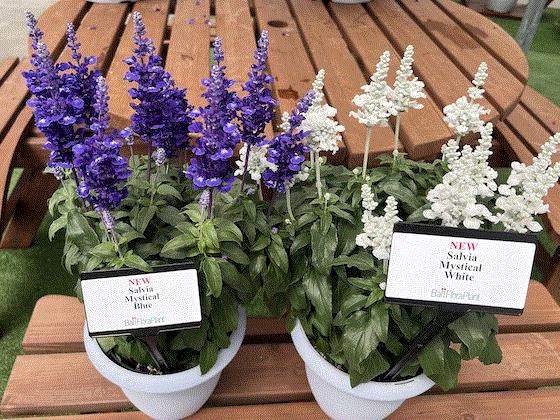
You can see these and a whole lot more in OUR VIDEO FROM BFP.
Okay, Bill, let’s continue with vegetative annuals and move across the greenhouse to Selecta One.

Selecta One: Petunia overhaul, geraniums from YecaFlora & dahlia mania
Bill: ‘Tis my pleasure, Bossman. How about a full series overhaul—that’s a big deal. The Mainstage Petunia series fits into Selecta’s petunia range as the largest type. The entire series has been upgraded to be as much as two to three weeks earlier than competitive series, meaning growers can send beautiful baskets to retail early in the season. They can be timed like Headliners (Selecta’s medium-vigor series). New colors added include Burgundy Sky (pictured), Magenta Glacier Sky, Merlot Glacier Sky and Light Blue Vein. I love the Sky patterns and have since Night Sky was introduced many years ago.

Might as well shout out the new Headliners, as well: Strawberry Picotee, Crimson and my favorite, Crystal Pink. Selecta product guru Gary Vollmer said this one is destined to be a top seller by 2028 because of its beautiful pink tones that don’t fade out in the sun.
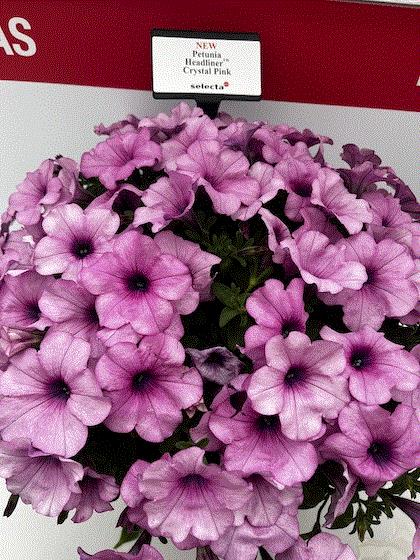
Chris: Like most flower consumers, I’m a sucker for amazing colors and we may see nothing more colorful than the two new Venti Dahlias—FireBurst and PinkBurst. Ventis are Selecta’s biggest and most vigorous dahlias; these two are both anenome-flowered, so you get the ring of petals of a daisy with a big cushion in the center. FireBurst is vibrant, primary red and yellow, while PinkBurst has pink petals and a slightly deeper center. Also nice, if not quite as spectacular, are the five new colors in the mid-sized Dalaya collection: Pink Lace, Purple Lace, Red Lace and Yellow Lace. “Lace” indicates white tips to the flower petals. Oh, and there’s Cranberry, too.

Bill: Ball has been shipping geraniums from its new YecaFlora farm in Mexico for a little more than two years now and the benefit growers gain is a consistent cold chain from the farm to the border via refrigerated trucks—better cutting quality. Now, 23 Selecta geranium varieties come from YecaFlora!
New in Selecta’s geranium assortment are all in the Moonlight (most compact) series: Purple + Big Eye and Scarlet Red.
That’s a wrap on Selecta One, so watch the VIDEO and see these varieties in 4K high def. How about moving on to perennials, Chris?

Darwin Perennials: New series & FYF additions
Chris: There’s no slowing of the popularity of these plants that come back every year and there’s no stopping the perennial breeders at Darwin ... boy, can they crank out the genetics. Starting with what I think is potentially the most significant introduction from the Ball trials: Phlox Candy Cloud. This is a P. subulata bred to be significantly later than standard P. subulata. Candy Cloud will bloom between mid-April and mid-May, “bridging the gap” between regular P. subulata and the main-season spring annuals and perennials, as they say. And as a bonus, Candy Cloud blooms for six to eight weeks (depending on the temperature, of course). The collection has four colors: Dark Pink, Pink, Lavender and Blue. Oh, I should mention that it requires a summer bulking and winter vernalization—it’s not a first-year flowering variety.
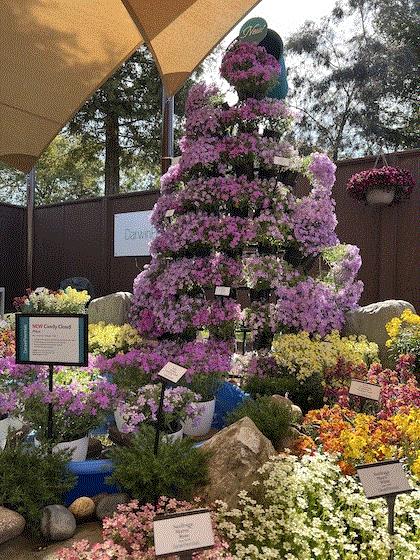
Bill: You mentioned the continued popularity of perennials and I think some of this is driven by all the new first-year flowering varieties and scheduling tools to produce them to hit different seasons and sales windows. Darwin’s penstemons are FYF and until this year only included the Rock Candy series (compact and great for 2.5-quart pots). Coral is the new color in that series. But the big news in Darwin penstemon is two NEW series!

Penstemon Mountain Treats is interspecific breeding and more of a medium-vigor series launching with five colors—Rose, Light Pink, Lavender, Red and Fuschia. The features include strong basal branching, high flower count and excellent environmental tolerance (they were bred in Pennsylvania).
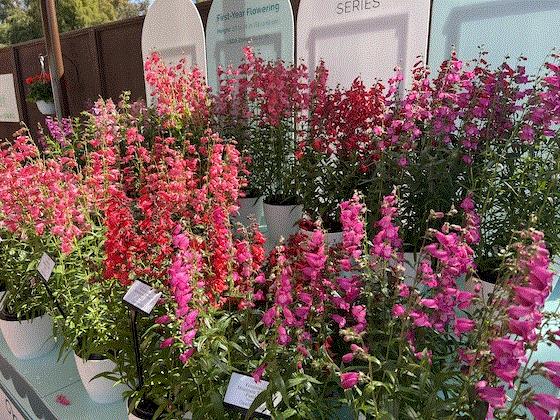
Last, but not least, is another new penstemon series called Summit Sweets that’s tall (2.5 to 3 feet) with blooms all the way to the top of the plant. Two colors are available for 2026—Purple and Ruby—with more to come, I’m sure.
Chris: Darwin had a display devoted to five first-year flowering perennials that like full sun. It included: Veronica Skyward Light Pink. Skyward now has four colors. It’s good for Zones 4b to 9a.
Monarda Bee Mine Purple grows to mid-height and is highly mildew resistant. Bee Mine comes in four colors and is good for Zones 4 to 9.
Gaillardia Guapa Flamenco Bicolor and Guapa Red are good for Zones 5a to 9b. “Guapa” means handsome (in the feminine sense) in Spanish.
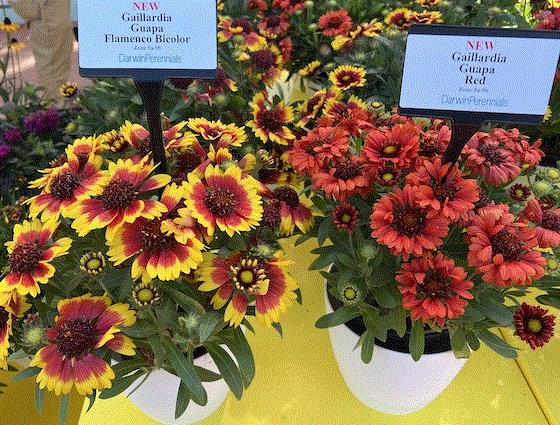
Coreopsis Sunfetti Yellow Bicolor is a standalone variety with a pretty mounding habit and good powdery mildew resistance, they say.
And, lastly, Rudbeckia Suntacular gets loads and loads of yellow flowers (even though it was only showing a few in the trial). It’s hardy from Zones 5a to 8b.
You can see all of these and more in OUR VIDEO.
Last, but not least, a visit to French cyclamen breeder Morel.

Morel: Cyclamen (and more)
Bill: Not just cyclamen, Chris. But we’ll get to that later. The newest cyclamen series from Morel is named Macaron and it’s the smallest of their “mini” type—bred for 2.5- to 4-in. pots. Andre from Morel said Macaron is the most genetically compact series on the market and it has high heat tolerance for summer production. Macaron launches with seven colors and two mixes.
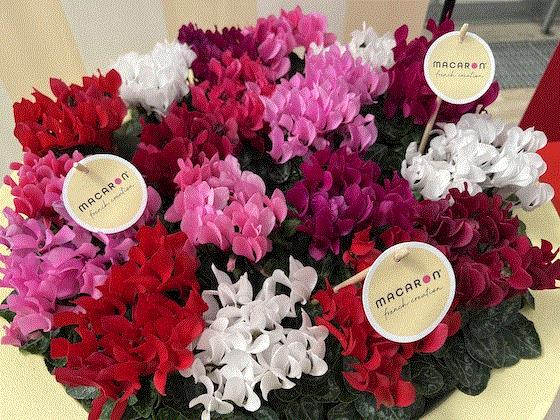
Also new from Morel are two for the miniature-sized Metis series—Coral Edge and Lilac.
Chris: The cyclamen breeders get into some pretty esoteric distinctions among their varieties. Such as the naming of a particular flower pattern like “Victoria,” which is a little band of color called a “crown.” Dreamscape Victoria Salmon is the first “Victoria” type within the midi Dreamscape series.
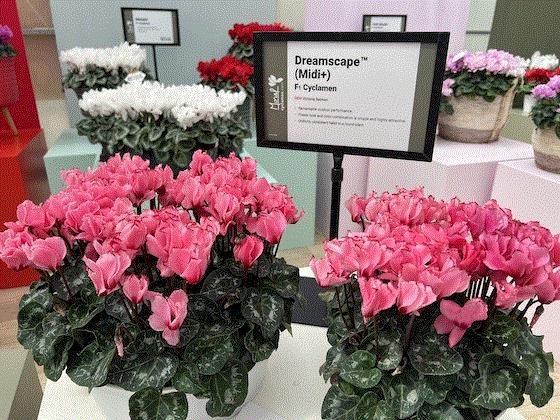
Bill: As I teased above, Morel is a cyclamen powerhouse and has been for generations and we learned they recently acquired a Dutch breeding company with some different cyclamen species (sort of “the origins” of modern cyclamen), including C. coum and C. hederifolium, which are landscape perennial types ... and hellebores! Now Morel is more than cyclamen with their new seed-raised perennial hellebores. As soon as young plant growers are lined up and these new cyclamen and hellebores are in production for North American distribution, we’ll let you know.
Alrighty then! Wrap up day one, Bossman.

Four days left to go
Chris: Whew! It was a day! Why do we always start with the biggest trial of the whole event? But it certainly gets us back into the swing of things, digging into the details of the new flower varieties for 2026 and beyond. We’ve got four more days and dozens of breeders left to see, so stick with us! Weigh in below to tell us what you want us to ask them on your behalf—remember, we do this for you.
Bill: If you like the daily newsletter, definitely watch our videos on the GrowerTalks YouTube channel, follow us on Instagram and Facebook, and I guarantee you’ll get the best coverage of California Spring Trials our industry has to offer! How’s that, Chris? As they say, always ask for the sale.
Chris: Time to hit the hay, Bill, because tomorrow we’ve got two stops and about a dozen companies to cover. It’s going to be another flower-filled day! See you tomorrow, everybody!
See you tomorrow!
Chris, Jen, Bill & Osvaldo
Chris Beytes
Editor-in-Chief
GrowerTalks/Green Profit
Jen Zurko
Editor
GrowerTalks/Green Profit
Bill Calkins
Senior Editor/Digital Editor
GrowerTalks/Green Profit
Osvaldo Cuevas
Video Producer
GrowerTalks/Green Profit
This email received by 31,751 lucky folks, and you're one of them!
Want to be one of the lucky sponsors who reach those 31,751 readers of Acres of Buzz from Spring Trials? Drop Paul Black a line and he'll tell you what a bargain it is!